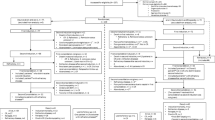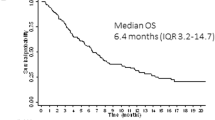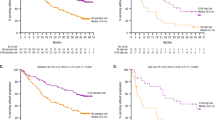Abstract
Untreated de novo (n=421) and secondary (n=189) acute myeloid leukemia (AML) patients ⩾60 years received intensified chemotherapy, including daunorubicin 60 mg/m2 and etoposide 100 mg/m2 during days 1, 2, 3 with cytarabine 100 mg/m2 during days 1–7, with a second induction if needed and one consolidation course with these drugs and doses for 2, 2 and 5 days, respectively. In all, 287 (47%) achieved complete remission (CR), 136 (22%) died and 187 (31%) were non-responders. CR rates were 27, 44 and 52% for complex karyotypes, rare aberrations and neither (P<0.001), 52 and 37% for de novo and secondary AML (P=0.003), and 53 and 42% for age 60–69 and ⩾70 years (P=0.015). In multivariable analysis, CR predictors included non-complex/non-rare karyotypes (P<0.001), de novo AML (P<0.001), better performance status (PS) (P<0.001) and younger age (P=0.001). Disease-free (DFS) and overall (OS) survival medians were 6.8 (95% CI: 6.2, 7.8) and 7.2 (95% CI: 6.4, 8.6) months. In multivariable analysis, DFS was shorter for complex karyotypes (P<0.001) and increasing white blood count (WBC) (P<0.001) and age (P=0.038), and OS for complex karyotypes (P<0.001), increasing WBC (P=0.001) and age (P<0.001), poorer PS (P<0.001) and secondary AML (P=0.010). Outcomes and prognostic factors were similar to those in previous Cancer and Leukemia Group B studies.
This is a preview of subscription content, access via your institution
Access options
Subscribe to this journal
Receive 12 print issues and online access
$259.00 per year
only $21.58 per issue
Buy this article
- Purchase on Springer Link
- Instant access to full article PDF
Prices may be subject to local taxes which are calculated during checkout


Similar content being viewed by others
References
Ries LAG, Melbert D, Krapcho M, Mariotto A, Miller BA, Feuer EJ et al. (eds). SEER Cancer Statistics Review, 1975–2000. National Cancer Institute: Bethesda, MD, http://seer.cancer.gov/csr/1975_2004/.
Löwenberg B, Zittoun R, Kerkhofs H, Jehn U, Abels J, Debusscher L et al. On the value of intensive remission-induction chemotherapy in elderly patients of 65+years with acute myeloid leukemia: a randomized phase III study of the European Organization for Research and Treatment of Cancer Leukemia Group. J Clin Oncol 1989; 7: 1268–1274.
Juliusson G, Antunovic P, Derolf Å, Lehmann S, Möllgård L, Stockelberg D et al. Age and acute myeloid leukemia: real world data on decision to treat and outcomes from the Swedish Acute Leukemia Registry. Blood 2009; 113: 4179–4187.
Mayer RJ, Davis RB, Schiffer CA, Berg DT, Powell BL, Schulman P et al. Intensive postremission chemotherapy in adults with acute myeloid leukemia. N Engl J Med 1994; 331: 896–903.
Appelbaum FR, Gundacker H, Head DR, Slovak ML, Willman CL, Godwin JE et al. Age and acute myeloid leukemia. Blood 2006; 107: 3481–3485.
Etienne A, Esterni B, Charbonnier A, Mozziconacci MJ, Arnoulet C, Coso D et al. Comorbidity is an independent predictor of complete remission in elderly patients receiving induction chemotherapy for acute myeloid leukemia. Cancer 2007; 109: 1376–1383.
Giles FJ, Borthakur G, Ravandi F, Faderl S, Verstovsek S, Thomas D et al. The haematopoietic cell transplantation comorbidity index score is predictive of early death and survival in patients over 60 years of age receiving induction therapy for acute myeloid leukaemia. Br J Haematol 2007; 136: 624–627.
Kantarjian H, O′Brien S, Cortes J, Giles F, Faderl S, Jabbour E et al. Results of intensive chemotherapy in 998 patients age 65 years or older with acute myeloid leukemia or high-risk myelodysplastic syndrome: predictive prognostic models for outcome. Cancer 2006; 106: 1090–1098.
Wheatley K, Brookes CL, Howman AJ, Goldstone AH, Milligan DW, Prentice AG et al. Prognostic factor analysis of the survival of elderly patients with AML in the MRC AML11 and LRF AML14 trials. Br J Haematol 2009; 145: 598–605.
Löwenberg B, Ossenkoppele GJ, van Putten W, Schouten HC, Graux C, Ferrant A et al. High-dose daunorubicin in older patients with acute myeloid leukemia. N Engl J Med 2009; 361: 1235–1248.
Pautas C, Merabet F, Thomas X, Raffoux E, Gardin C, Corm S et al. Randomized study of intensified anthracycline doses for induction and recombinant interleukin-2 for maintenance in patients with acute myeloid leukemia age 50 to 70 years: results of the ALFA-9801 study. J Clin Oncol 2010; 28: 808–814.
Baer MR, George SL, Dodge RK, O′Loughlin KL, Minderman H, Caligiuri MA et al. Phase 3 study of the multidrug resistance modulator PSC-833 in previously untreated patients 60 years of age and older with acute myeloid leukemia: Cancer and Leukemia Group B Study 9720. Blood 2002; 100: 1224–1232.
Baer MR, George SL, Caligiuri MA, Sanford BL, Bothun SM, Mrózek K et al. Low-dose interleukin-2 immunotherapy does not improve outcome of patients 60 years and olderwith acute myeloid leukemia in first complete remission: Cancer and Leukemia Group B study 9720. J Clin Oncol 2008; 30: 4934–4939.
Lee EJ, George SL, Caligiuri M, Szatrowski TP, Powell BL, Lemke S et al. Parallel phase I studies of daunorubicin given with cytosine arabinoside and etoposide with or without the multidrug resistance modulator PSC-833 in previously untreated patients 60 years of age or older with acute myeloid leukemia: results of Cancer and Leukemia Group B study 9420. J Clin Oncol 1999; 17: 2831–2839.
Cheson BD, Cassileth PA, Head DR, Schiffer CA, Bennett JM, Bloomfield CD et al. Report of the National Cancer Institute-sponsored workshop on definitions of diagnosis and response in acute myeloid leukemia. J Clin Oncol 1990; 8: 813–819.
Cheson BD, Bennett JM, Kopecky KJ, Büchner T, Willman CL, Estey EH et al. Revised recommendations of the international working group for diagnosis, standardization of response criteria, treatment outcomes, and reporting standards for therapeutic trials in acute myeloid leukemia. J Clin Oncol 2003; 21: 4642–4649.
Farag SS, Archer KJ, Mrózek K, Ruppert AS, Carroll AJ, Vardiman JW et al. Pretreatment cytogenetics add to other prognostic factors predicting complete remission and long-term outcome in patients 60 years of age or older with acute myeloid leukemia: results from Cancer and Leukemia Group B 8461. Blood 2006; 108: 63–73.
Kaplan EL, Meier P . Nonparametric estimation from incomplete observations. J Am Stat Assoc 1958; 53: 457–481.
Stone RM, Berg DT, George SL, Dodge RK, Paciucci PA, Schulman PP et al. Postremission therapy in older patients with primary acute myeloid leukemia: a randomized trial comparing mitoxantrone and intermediate-dose cytarabine with standard-dose cytarabine. Blood 2001; 98: 548–553.
Novitzky N, Thomas V, Abrahams L, du Toit C, McDonald A . Increasing dose intensity of anthracycline antibiotics improves outcome in patients with acute myelogenous leukemia. Am J Hematol 2004; 76: 319–329.
Kolitz JE, George SL, Dodge RK, Hurd DD, Powell BL, Allen SL et al. Dose escalation studies of cytarabine, daunorubicin, and etoposide with and without multidrug resistance modulation with PSC-833 in untreated adults with acute myeloid leukemia younger than 60 years: final induction results of Cancer and Leukemia Group B Study 9621. J Clin Oncol 2004; 22: 4290–4301.
Kolitz JE, George SL, Marcucci G, Vij R, Powell BL, Allen SL et al. A randomized comparison of induction therapy for untreated acute myeloid leukemia (AML) in patients < 60 years using P-glycoprotein (Pgp) modulation with Valspodar (PSC833): preliminary results of Cancer and Leukemia Group B study 19808. Blood 2005; 106: 122a–123a (abstract).
Fernandez HF, Sun Z, Yao X, Litzow MR, Luger SM, Paietta EM et al. Anthracycline dose intensification in acute myeloid leukemia. N Engl J Med 2009; 361: 1249–1259.
Burnett AK, Milligan D, Goldstone A, Prentice A, McMullin M-F, Dennis M et al. The impact of dose escalation and resistance modulation modulation in older patients with acute myeloid leukaemia and high risk myelodysplastic syndrome: the results of the LRF AML 14 trial. Br J Haematol 2009; 145: 318–332.
Feldman EJ, Seiter K, Damon L, Linker C, Rugo H, Ries C et al. A randomized trial of high-vs standard-dose mitoxantrone with cytarabine in elderly patients with acute myeloid leukemia. Leukemia 1997; 11: 485–489.
Reiffers J, Huguet F, Stoppa AM, Molina L, Marit G, Attal M et al. A prospective randomized trial of idarubicin vs daunorubicin in combination chemotherapy for acute myelogenous leukemia of the age group 55 to 75. Leukemia 1996; 10: 389–395.
Löwenberg B, Suciu S, Archimbaud E, Haak H, Stryckmans P, de Cataldo R et al. Mitoxantrone versus daunorubicin in induction-consolidation chemotherapy—the value of low-dose cytarabine for maintenance of remission, and an assessment of prognostic factors in acute myeloid leukemia in the elderly: final report of the Leukemia Cooperative Group of the European Organization for the Research and Treatment of Cancer and the Dutch-Belgian Hemato-Oncology Cooperative Hovon Group randomized phase III study AML-9. J Clin Oncol 1998; 16: 872–881.
Archimbaud E, Jehn U, Thomas X, De Cataldo F, Fillet G, Belhabri A et al. Multicenter randomized phase II trial of idarubicin vs mitoxantrone, combined with VP-16 and cytarabine for induction/consolidation therapy, followed by a feasibility study of autologous peripheral blood stem cell transplantation in elderly patients with acute myeloid leukemia. Leukemia 1999; 13: 843–849.
Rowe JM, Neuberg D, Friedenberg W, Bennett JM, Paietta E, Makary AZ et al. A phase 3 study of three induction regimens and of priming with GM-CSF in older adults with acute myeloid leukemia: a trial by the Eastern Cooperative Oncology Group. Blood 2004; 103: 479–485.
Ross DD, Doyle LA, Yang W, Tong Y, Cornblatt B . Susceptibility of idarubicin, daunorubicin, and their C-13 alcohol metabolites to transport-mediated multidrug resistance. Biochem Pharmacol 1995; 50: 1673–1683.
Smeets MEP, Raymakers RAP, Vierwinden G, Pennings AHM, Boezeman J, Minderman H et al. Idarubicin DNA intercalation is reduced by MRP1 and not Pgp. Leukemia 1999; 13: 1390–1398.
Mandelli F, Vignetti M, Suciu S, Stasi R, Petti MC, Meloni G et al. Daunorubicin versus mitoxantrone versus idarubicin as induction and consolidation chemotherapy for adults with acute myeloid leukemia: the EORTC and GIMEMA Groups Study AML-10. J Clin Oncol 2009; 27: 5397–5403.
Bishop JF, Lowenthal RM, Joshua D, Matthews JP, Todd D, Cobcroft R et al. Etoposide in acute nonlymphocytic leukemia. Blood 1990; 75: 27–32.
Leith CP, Kopecky KJ, Godwin J, McConnell T, Slovak ML, Chen I-M et al. Acute myeloid leukemia in the elderly: assessment of multidrug resistance (MDR1) and cytogenetics distinguishes biologic subgroups with remarkably distinct responses to standard chemotherapy. A Southwest Oncology Group study. Blood 1997; 89: 3323–3329.
van der Holt B, Löwenberg B, Burnett AK, Knauf WU, Shepherd J, Piccaluga PP et al. The value of the MDR1 reversal agent PSC-833 in addition to daunorubicin and cytarabine in the treatment of elderly patients with previously untreated acute myeloid leukemia (AML), in relation to MDR1 status at diagnosis. Blood 2005; 106: 2646–2654.
Matsouka P, Pagoni M, Zikos P, Giannakoulas N, Apostolidis I, Asprogeraka T et al. Addition of cyclosporin-A to chemotherapy in secondary (post-MDS) AML in the elderly. A multicenter randomized trial of the Leukemia Working Group of the Hellenic Society of Hematology. Ann Hematol 2006; 85: 250–256.
Qadir M, O’Loughlin KL, Fricke SM, Williamson NA, Greco WR, Minderman H et al. Cyclosporin A is a broad-spectrum multidrug resistance modulator. Clin Cancer Res 2005; 11: 2320–2326.
Büchner T, Hiddemann W, Berdel WE, Wörmann B, Schoch C, Fonatsch C et al. 6-Thioguanine, cytarabine, and daunorubicin (TAD) and high-dose cytarabine and mitoxantrone (HAM) for induction, TAD for consolidation, and either prolonged maintenance by reduced monthly TAD or TAD-HAM-TAD and one course of intensive consolidation by sequential HAM in adult patients at all ages with de novo acute myeloid leukemia (AML): a randomized trial of the German AML Cooperative Group. J Clin Oncol 2003; 21: 4496–4504.
Chau M, Christensen JL, Ajami AM, Capizzi RL . Amonafide, a topoisomerase II inhibitor, is unaffected by P-glycoprotein-mediated efflux. Leuk Res 2008; 32: 465–473.
Becker H, Marcucci G, Maharry K, Radmacher MD, Mrózek K, Margeson D et al. Favorable prognostic impact of NPM1 mutations in older patients with cytogenetically normal primary acute myeloid leukemia and associated gene-and microRNA-expression signatures: a Cancer and Leukemia Group B study. J Clin Oncol 2010; 28: 596–604.
Acknowledgements
The research for CALGB 9720 was supported, in part, by grants from the National Cancer Institute (CA31946) to the Cancer and Leukemia Group B (Richard L. Schilsky, MD, Chairman) and to the CALGB Statistical Center (Stephen George, PhD, CA33601), and by grants CA31983 and CA02599 (to MRB), CA33601 (to SLG and BLS), CA77658, 101140 and grants from the Coleman Leukemia Research Foundation (to KM, MAC, CDB), CA35279 (to JEK), CA47577 (to JOM), CA32291 (to RMS), CA03927 (to BLP) and CA41287 (to RAL). The authors thank the many patients, treating physicians, nurses and CALGB clinical research associates who participated in this study, and also thank CALGB Protocol Coordinator Michael Kelly for his assistance.
Author information
Authors and Affiliations
Consortia
Corresponding author
Ethics declarations
Competing interests
The authors declare no conflict of interest.
Additional information
This work was presented in part at the American Society of Hematology 2007 Annual Meeting.
Disclaimer
The content of this manuscript is solely the responsibility of the authors and does not necessarily represent the official views of the National Cancer Institute.
A list of CALGB institutions that participated in this study and principal investigators is provided in the Supplementary Information.
Supplementary Information accompanies the paper on the Leukemia website
Rights and permissions
About this article
Cite this article
Baer, M., George, S., Sanford, B. et al. Escalation of daunorubicin and addition of etoposide in the ADE regimen in acute myeloid leukemia patients aged 60 years and older: Cancer and Leukemia Group B Study 9720. Leukemia 25, 800–807 (2011). https://doi.org/10.1038/leu.2011.9
Received:
Revised:
Accepted:
Published:
Issue Date:
DOI: https://doi.org/10.1038/leu.2011.9
Keywords
This article is cited by
-
The dual role of autophagy in acute myeloid leukemia
Journal of Hematology & Oncology (2022)
-
A precision medicine classification for treatment of acute myeloid leukemia in older patients
Journal of Hematology & Oncology (2021)
-
Complex karyotype in de novo acute myeloid leukemia: typical and atypical subtypes differ molecularly and clinically
Leukemia (2019)
-
Prognostic and biologic significance of DNMT3B expression in older patients with cytogenetically normal primary acute myeloid leukemia
Leukemia (2015)
-
GAS6 expression identifies high-risk adult AML patients: potential implications for therapy
Leukemia (2014)



